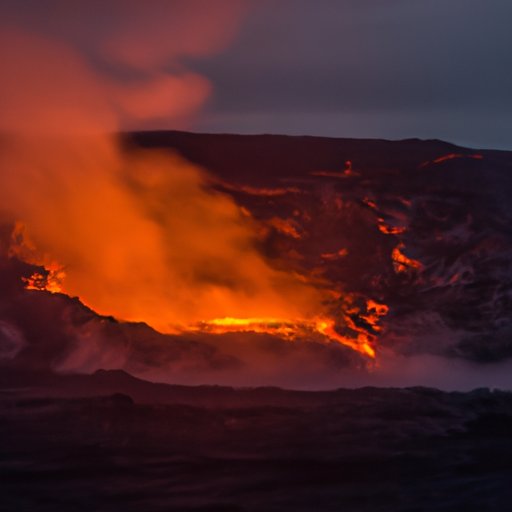Introduction
A volcano is a geological landform created when molten rock, or magma, erupts from the Earth’s surface. Volcanoes can be found all over the world, from North and South America to Europe, Asia, and Africa. Some of the most powerful and impressive volcanoes are located in Hawaii, home to the world’s largest active volcano: Mauna Loa.
Mauna Loa stands at an impressive 4,169 meters (13,678 feet) above sea level, making it the world’s largest mountain in terms of area and volume. It covers an area of 5,271 square kilometers (2,035 square miles) and has a total volume of around 18,000 cubic kilometers (4,300 cubic miles).
Exploring the World’s Largest Volcano: A Comprehensive Guide
Mauna Loa is located on the Big Island of Hawaii and is part of the Hawaiian-Emperor seamount chain, a string of underwater mountains extending for thousands of miles across the Pacific Ocean. The volcano is made up of five overlapping shield volcanoes, each formed by hundreds of successive lava flows covering the previous layers.
Mauna Loa first erupted around 700,000 years ago and has been active ever since. The most recent eruption occurred in 1984, when a series of fissures opened up along the volcano’s east rift zone. This event lasted two months and released around 0.2 cubic kilometers (0.05 cubic miles) of lava.
Climbing Mauna Loa is a popular activity amongst hikers and adventurers. The hike to the summit is roughly 16 kilometers (10 miles) long and takes an experienced hiker around eight hours. The terrain is mostly barren and rocky, with little vegetation, so it is advisable to bring plenty of water and snacks to keep you going.
The Biggest and Most Powerful Volcanoes on Earth
Mauna Loa may be the world’s largest active volcano, but there are many other large and powerful volcanoes scattered across the globe. Below is a list of some of the biggest and most powerful volcanoes on Earth:
- Mauna Loa – Big Island, Hawaii (4,169 meters)
- Mt. Kilimanjaro – Tanzania (5,895 meters)
- Mt. St. Helens – Washington, USA (2,549 meters)
- Mt. Etna – Sicily, Italy (3,329 meters)
- Klyuchevskaya Sopka – Kamchatka Peninsula, Russia (4,750 meters)
- Mount Fuji – Honshu, Japan (3,776 meters)
Each of these volcanoes is impressive in its own right, but Mauna Loa is by far the largest and most powerful of them all. Its immense size and power have caused catastrophic damage in the past, including the devastating eruption of 1950 which destroyed thousands of acres of forests and farmland.
How to Climb the World’s Largest Volcano
For those looking to experience the challenge of climbing the world’s largest volcano, there are a few important things to consider. Firstly, it is essential to prepare properly for the climb. Make sure to bring plenty of food, water, and warm clothing as the weather can change quickly at higher altitudes. It is also advisable to check the latest weather forecast before heading out.
Safety should always be a priority when climbing any volcano, and Mauna Loa is no exception. Make sure to stay on marked trails, listen out for warning signs, and keep away from areas that could be affected by falling rocks. If you are feeling unwell or experiencing any kind of physical discomfort, it is best to turn back and seek medical attention.
Finally, make sure to enjoy your time on the mountain. Experienced climbers recommend stopping regularly to take in the incredible views and appreciate the unique beauty of the natural environment. Mauna Loa is a stunning sight to behold, and an incredible experience to remember.
A Look at the World’s Largest Volcano and Its Eruptions
Mauna Loa is an active volcano and can produce several different types of eruptions. These include explosive eruptions, where large amounts of ash and gas are expelled into the atmosphere; effusive eruptions, where lava slowly oozes out of the volcano; and pyroclastic flows, which are incredibly destructive and involve fast-moving clouds of hot gas and ash.
Eruptions from Mauna Loa can have a huge impact on the surrounding environment. In addition to destroying homes and buildings, the lava can also cause extensive damage to crops, roads, and other infrastructure. As such, it is important to monitor the volcano closely and be prepared to evacuate if necessary.
An Overview of the World’s Largest Volcano and Its Impact on the Environment
Mauna Loa’s eruptions have had both short-term and long-term impacts on the environment. In the immediate aftermath of an eruption, the affected areas can suffer from air and water pollution, loss of vegetation, and disruption to local ecosystems. In the longer term, the lava flows can create new landforms and habitats, helping to diversify the landscape and support new species of plants and animals.
Human activities can also have a significant impact on the environment, particularly around volcanoes. Deforestation, agricultural practices, and urban development can all contribute to increased volcanic activity, so it is important to be aware of the potential risks and take appropriate measures to reduce them.
Conclusion
Mauna Loa is an awe-inspiring sight to behold and an incredible challenge to conquer. Standing at over 4,000 meters above sea level, it is the world’s largest active volcano and has been erupting for centuries. It is important to be aware of the potential dangers posed by the volcano and take precautions before attempting to climb it, but with the right preparation and safety measures, the experience can be unforgettable.


